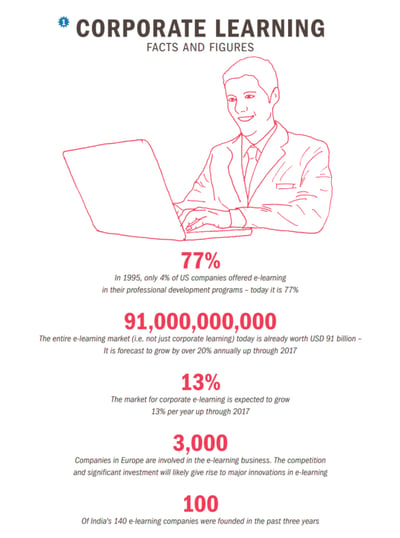
6 best approaches to e-learning and e-training
Geschreven door Jan-Hendrik Vervelde | January 15, 2016Online solutions are being used more often in corporate learning, which results in the e-learning and e-training market developing constantly. This is not strange: managers are under pressure to cut costs and time, while globalisation and growing diversity drive new training challenges. In certain of these business environments, the advantages of online training are optimal. Roland Berger’s strategy consultants examined six best approaches regarding e-learning and e-training.
 1. Participants in a wide geographical area
1. Participants in a wide geographical area
Traditional physical training and corporate learning are difficult to organise if the participants are working in different locations. There has to be a central location and you can be faced with high travel cost and time waste. These things play no role in online training. On top of that, results of different locations can be compared, which can lead to interesting insights.
2. Different level of knowledge and skill
Small chance that your employees are all on the same level of the skills that you want to improve. Therefore it is useless to offer them the exact same training. It is simple to determine everyone’s level online and to adept the training accordingly. A potential physical training can help to add depth to the acquired skills afterwards.
3. Constant development during working hours
For many managers it is not ideal if participants spend a whole afternoon training. Also, some knowledge and skills need to be kept up-to-date constantly. It is more efficient if a training is available online at every moment, on the road and on a smartphone as well.
 4. Measuring individual progress
4. Measuring individual progress
Organisations that expect their employees to reach a certain level, see many advantages in e-training: individual testing and assessment gives insight in everyone’s progress directly. New employees, for example, who need to learn the correct behaviour towards customers in a short amount of time.
5. General information for large groups
If a large group of employees needs to learn the same information or skills, one needs to be careful not to use the ‘one size fits all’ approach, resulting in no one learning anything. E-learning, however, facilitates a Personal Learning Environment (PLE): each participant practices when and where he or she prefers.
6. More than sheer knowledge transaction
When the goal is to yield a change in behaviour instead of sheer knowledge transaction, blended learning and a focus on communication and collaboration become more important. The more varied the goal of the training, the more varied the method should be.
Curious to see what else Roland Berger's consultants researched? Read it in full here. Or want to know more about how our e-training works? Click below!



